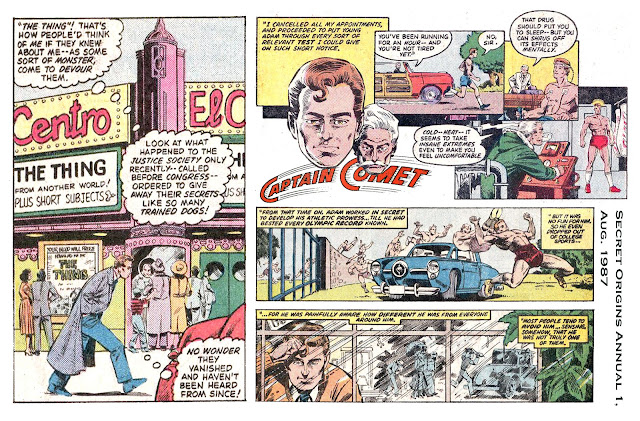October 1951: Granite Guys and Gravity Gone
In Strange Adventures 13 (Oct. 1951), Adam Blake spends his library
lunch hour rocketing off to investigate stone creatures that have mysteriously
appeared in Geyser Park, Wyoming (presumably Yellowstone).
Titles edited by Julius Schwartz would
often spotlight natural wonders like geysers, waterspouts and the aurora
borealis in their stories, providing the opportunity for readers to acquire
some painless scientific knowledge through footnotes.
In the course of the adventure When the Earth Was Kidnapped, our planet
is dragged toward the blue sun of Alpha Centauri. Gravity goes awry, causing
Midwest City citizens to float into the air.
 |
| Justice League of America 5 (1961) |
Stone giants, Earth being dragged
through space, gravity upended, a city beneath the Earth, alien beings rocketed
back to Alpha Centauri — DC knew how to pack a lot of sensational stuff into
eight short pages in 1951. With three other stories and various feature pages in
a single issue, that was one dime well spent!
When a mob panicked by Earth’s
peril tries to smash the stone men, Captain Comet stops them with a scolding:
“Men, lynch law isn’t American! Besides, these creatures may be innocent! Go
back to your homes…”
Captain Comet was not only
futuristic. He was optimistic.
Coincidentally, an almost
identical scene would appear in the film Superman
and the Mole Men, released in November 1951. The Man of Steel, too, would
defend alien beings from an unthinking lynch mob.
Captain Comet’s peaceful
resolution of the interstellar conflict telegraphs what would be another of
Schwartz’s recurring themes, seen again and again in Strange Adventures even after the superhero had departed — that
intelligent beings can often resolve their differences to the advantage of all
concerned, if they stop to use their heads instead of fighting.
Having saved his own planet and
an alien race, Captain Comet wraps up his fanciful exploit with a quick nod to The Wizard of Oz.
“The good old sun!” exclaims a
park ranger. “You did it, Captain Comet!
You brought us home — to our own
orbit!”
Captain Comet thinks, “I guess
there’s no place like home — for us
or the stone people!”





Sam Kujava:
ReplyDelete"Captain Comet was not only futuristic. He was optimistic." Well said, Dan, and that sums up DC Comics in that era. A style, a tone, that when abandoned or lost, would not return.
Foster H. Coker III:
ReplyDeleteGreat post! I have had a soft spot for Captain Comet since I first met the character in SSoSV #2 in mid-1976.
Michael Wurl:
ReplyDeleteYour posts are always well written and detailed, as well as fun and enlightening.
Great stuff!